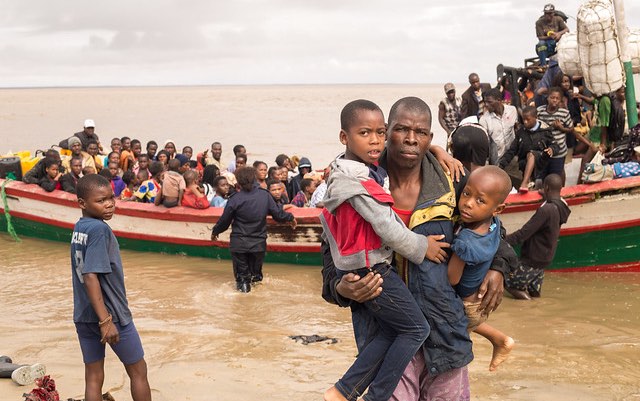Cyclone Idai struck Beira, the fourth largest city in Mozambique, in mid-March with torrential rains and winds of more than 190 km per hour. It took days for the sheer size of the resulting disaster to be understood. Dramatic pictures and video showed that the cyclone had left behind an inland sea up to 6 meters deep. Hundreds of people died in the storm and its immediate aftermath, and millions will be affected, potentially for years to come.
Increases in the frequency and intensity of extreme weather events, such as Cyclone Idai, are increasingly viewed as a consequence of climate change. This is true globally, but particularly for areas like southern Africa.
Climate-related disasters harm growth and development prospects. Climate change, with its more extreme weather events and rising seas, will both broaden and intensify these impacts on poor communities—and entire countries. Poor people in poor countries are most vulnerable to disasters such as Cyclone Idai.
The research
Just over five years ago a study was conducted to evaluate the effects of climate change on Mozambique. A key challenge in evaluating the implications of climate change, and thus appropriate responses, is uncertainty in what the future holds. While there’s certainty that Mozambique (along with everywhere else) will be warmer, we are much less certain about rainfall.
Will it rain more or less? Will the timing of rainfall change? Will rainfall come in short bursts with long dry periods in between? Will the frequency and intensity of cyclone events increase? We don’t know the answer to these questions with certainty.
To address this uncertainty, the study sought to expose Mozambique to the full range of potential climate futures out to 2050. Some are wetter, some are drier, some involve shifts in the timing of rainfall and others don’t. While all climate futures are warmer, some project greater or lesser temperature increases. By analyzing the full distribution of climate outcomes, researchers could obtain a distribution of associated economic outcomes.
At the most negative extreme of this distribution, the study found that the economy of Mozambique may contract by up to 13% in 2050 compared with a fictional no climate change scenario—and assuming global policy fails to constrain emissions growth. These strong effects on GDP are principally the result of repeated climatic shocks.
To arrive at these conclusions, the study linked together a series of models that converted future weather patterns, mainly temperature and precipitation, into river flow, hydropower output, irrigation potential, flood events, and crop growth into economic outcomes. This was done for more than 400 future climates that were selected to reflect the best estimate of the distribution of future climates.
The figure below shows a distribution of the likely effects of climate change on Mozambique’s GDP around 2050 compared with a fictional, no climate change baseline, based on the results of all climate scenarios. The vertical axis shows a measure of the likelihood of the outcome. For most climate futures, climate change is likely to reduce GDP in 2050 by between 1 and 5%.
Source: Arndt and Thurlow (2015).
The figure also shows that reductions of more than 5% of GDP by 2050 are less likely but still perfectly possible. Cyclone Idai is a good example of a low frequency but high impact extreme event. The left hand side of the distribution (the “long tail”) reflects climate futures where repeated extreme events strike economically important zones.
Unfortunately, it’s not clear when or where the next disaster will strike southern Africa. However, we can say that the odds are changing—and not for the better, as shown by Figure 1.
People living in the Beira corridor, like citizens almost everywhere, are more likely to confront more extreme climate-related disasters in the future such as droughts, floods, and cyclones. As a result, it’s important to build long-term resilience (alongside pursuing active global policies to reduce emissions and hence limit future climate change).
Way forward from Idai’s aftermath
In the short term, governments and humanitarian organizations must respond quickly and robustly to Cyclone Idai. They must address both the immediate crisis and minimize the long-term adverse effects on livelihoods and development prospects of those directly affected and those impacted indirectly.
Many tools now exist to identify where the poorest and most affected communities are in such disasters. Needs location and assessment combined with infrastructure restoration can generate swift responses. Social protection programs that can be flexibly adjusted in times of disasters are also important and can dramatically improve the outlook and the futures of the people affected by such disasters, especially the rural poor.
Effective disaster response is particularly important for young children. If young children suffer persistent undernutrition in the cyclone’s wake, the resulting lower cognitive skills will reduce lifetime earnings. In this case, the effects of Cyclone Idai would linger for generations, shaping the lives of the children and grandchildren of those who lost everything during Idai.
In the longer term, societies everywhere need to grapple with a warmer, more volatile, and less predictable climate, along with sea level rises that will substantially magnify the risks associated with cyclone strikes such as Idai. This means: Recognition of the role of extreme events as drivers of strongly negative outcomes (in, for example, infrastructure planning); planning for flexibility (we don’t want to fixate on coping with a drier future when a wetter one is also quite possible or vice versa); and increased investment in win-win solutions, such as soil erosion control measures that enhance agricultural productivity while reducing river siltation.
Finally, it calls for education, information, access to improved technologies and other resources so that an empowered citizenry is better prepared to confront development challenges in a context of climate change.
Channing Arndt is Director of IFPRI’s Environment and Production Technology Division (EPTD); Claudia Ringler is EPTD Deputy Director and co-leader of the CGIAR Research Program on Water, Land and Ecosystems (WLE) Flagship Program on Variability, Risks and Competing Uses. This post first appeared on the Conversation.







